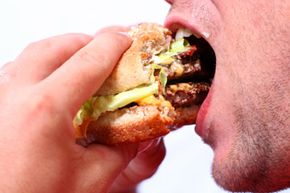You may have a
love-hate relationship with fat and not even realize it. Fat may inspire loathing when it's installed on your thighs or midsection, but it may taste positively divine on your tongue. Contrary to popular wisdom, the human palate can taste fat. You might have been taught in school that humans can taste only salty, bitter, sour and sweet flavors, but ongoing research is revealing that the sense of taste is a much more flexible, rich and complex mechanism than first thought.
Advertisement
Humans can taste different flavors all over the mouth in varying degrees, and you'll have to add at least two more flavor varieties to the traditional four: savory and fat. Yes, fat does have flavor, and a couple of studies, a 2001 Purdue University study and one conducted at the University of Burgundy by nutritionist Philippe Besnard, indicate that tasting fat even causes an increase in blood fat levels and other digestive changes in the body [source: Graham].
When Men Lived in Caves . . .
When you think about it, there's an advantage to being able to taste and enjoy the flavor of fat. For most of the history of mankind, overeating hasn't been much of a problem, but starvation has. Fat is easily converted into energy, and fats are also among the most calorie-dense dietary options on the planet, so a predisposition for eating fat might have meant the difference between surviving a harsh winter and perishing before spring. When you're struggling to fit into your skinny jeans after a weekend encounter with a pan of brownies this may be hard to appreciate, but survival trumps the vagaries of fashion every time.
Fat has a couple of other advantages when it comes to eating, too. It's an important ingredient in many tasty dishes, such as desserts and sauces, because it combines well with grains and sugars, and when it's marbled in meats, it helps make them moist and tender. Many high-calorie foods served during the holidays celebrate bounty with the liberal addition of cream and butter. Cheesecake, eggnog, glazed ham and sweet potato pie all have high levels of fat -- after all, winter is coming, and man once needed the extra reserves.
Where's the Flavor?
Many low-calorie food options eliminate fat as an ingredient, and because fat is high in calories -- nine calories per gram -- this seems like a practical approach. The problem is that little to no fat often means little to no flavor. To help keep the calories down but still get a taste of the fat your body craves, try reducing the portion size of the foods you eat. The increased fat content may compensate for the smaller portion, and your body will feel fuller and more satisfied with less. To trick yourself into thinking you're eating as much as everyone else, put your portion on a smaller plate and eat slowly [source: Bobroff].
Whatever approach you take to keep your calorie count down while still adding some flavor to your diet, keep in mind the dietary guidelines published by the Department of Health and Human Services. Fats shouldn't constitute more than 25 to 30 percent of your total calories, and of that 25 to 30 percent, less than 10 percent should be saturated fat [Source: Bonne].
So, even when you're dieting, isn't it nice to know that it may be a good idea to put a little oil in your salad dressing or indulge in a potato chip once in a while? You may eat only a few chips, but those fat-laden snacks may be just what you need.
For more information on fat and how to cut back on it, see the links on the following page.
Advertisement


